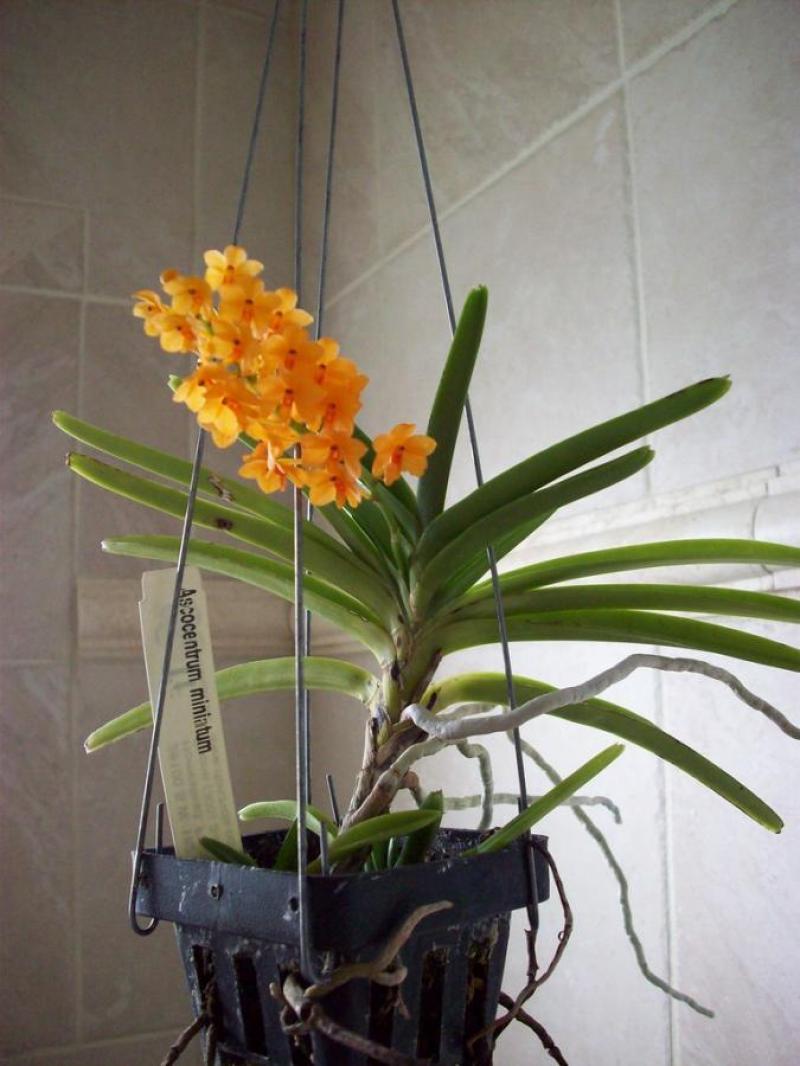Ascocentrum miniatum
Also known as: The Rust Red Ascocentrum in the subfamily: Epidendroideae
Native to: Calabarzon - Philippines Central Luzon - Philippines Loei - Thailand
General Information
The Rust Red Ascocentrum is a miniature monopodial cool to warm growing orchid belonging to the sub family Epidendroideae native to Philippines and Thailand.
Plant Description
Monopodial. Grows to 10-20cm. Each new growth has numerous thick erect, rigid leaves that grow to 0.3-20cm long
Flowers
Numerous blossoms appear during Winter and Spring
Blooming Season
- Spring
- Winter
Substrate(s)
- Coarse
- Medium
- Bark
- Charcoal
Climate
The orchids are well adapted for hot weather, accompanied by sporadic, unpredictable rainfall and a generally dry climate. They can tolerate a lot of neglect as they are quite used to it, however they can be prone to underwatering and may collapse in cold, wet weather.
For this reason it's best to dedicate a sheltered, protected area for them where the watering can be controlled, such as a corner of a greenhouse or in a sheltered balcony. They can also do well hung near the roof of a shadehouse or sheltered greenhouse where they receive the extra heat but not as much water as other plants.
Grows at low to high elevations. Rainfall ranges from 8mm to 292mm per day, heaviest in September and lightest in January. Humidity ranges from 58% to 83%, highest in August and lowest in March. Temperature ranges from 12C to 34C, highest in April (22C to 34C) and lowest in January (12C to 27C).Watering
These orchids are sensitive to excessive watering and should only be watered when they look thirsty. Water infrequently and ensure that the roots are dry before watering. Keep an eye on them especially during hot weather as overwatering can lead to rot, whereas underwatering may result in wilting or shriveling, which while unattractive, will not kill the plant.
Fertiliser
These orchids do not need to be regularly fertilised and roots may be sensitive to salt build-up, dying back and therefore impairing the plants growth or even killing it.
If fertilising, use half to quarter of the recommended amount of fertiliser. If they receive fertiliser as part of a collection, be sure to flush out the pots regularly with fresh water and monitor the roots by checking how much resistance is given by the plant when nudged in its pot or mount. If the plant becomes wobbly or loose, repot in fresh mix or rinse the media/mount thoroughly and do not fertilise for at least 3 months.
Use balanced fertiliser during Spring and Summer. Apply fertiliser regularly at half strength year round. This plant is sensitive so apply fertiliser sparingly at one quarter recommended strength or less. Use a high Nitrogen fertiliser during Spring and Summer. Use a high Phosphorous fertiliser during Summer.Potting
Use water retentive media such as moss to prevent roots from drying out quickly This plant does very well in baskets or suspended pots This plant does well mounted to Tree trunks, Fern slabs or Cork slabs. Repotting is best done annually.










![© [╠╣♥ŃEҰ] -น้ำผึ้ง-](/orchid-images/orchids/a/ascocentrum/miniatum/3365044978_15cd753d87_b.jpg?w=98)










